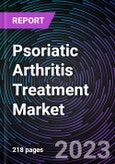This report comes with 10% free customization, enabling you to add data that meets your specific business needs.
Psoriatic Arthritis Treatment Market by Drug Type
- NSAIDs
- DMARDs
- Biologics
Psoriatic Arthritis Treatment Market by Type
- Prescription
- OTC
Psoriatic Arthritis Treatment Market by Route of Administration
- Injectable
- Oral
- Topical
Psoriatic Arthritis Treatment Market by Geography
- North America
- Europe
- Asia Pacific
- Rest of the World
Here is an overview of the key aspects of the psoriatic arthritis treatment market:
Nonsteroidal Anti-Inflammatory Drugs (NSAIDs): NSAIDs are commonly used as first-line treatment for PsA to manage pain, inflammation, and stiffness. These medications help reduce symptoms and improve joint function. Over-the-counter NSAIDs like ibuprofen and naproxen, as well as prescription-strength options, are available.Disease-Modifying Antirheumatic Drugs (DMARDs): DMARDs are used to slow down the progression of joint damage in PsA and reduce inflammation. Traditional DMARDs, such as methotrexate, sulfasalazine, and leflunomide, may be prescribed. Additionally, targeted synthetic DMARDs like apremilast and Janus kinase (JAK) inhibitors such as tofacitinib and baricitinib have shown efficacy in psoriatic arthritis treatment.
Biologic Therapies: Biologic drugs are a class of medications that target specific molecules involved in the immune response. Biologics, including tumor necrosis factor (TNF) inhibitors (e.g., etanercept, adalimumab), interleukin (IL)-17 inhibitors (e.g., secukinumab, ixekizumab), and IL-23 inhibitors (e.g., ustekinumab, guselkumab), have revolutionized PsA treatment. These drugs are typically administered by injection or infusion and are used when other treatments have been inadequate.
Corticosteroids: Corticosteroids, such as prednisone, may be used to provide short-term relief from inflammation and pain in psoriatic arthritis. They are usually administered orally or through injections directly into the affected joints. However, long-term use of corticosteroids is generally avoided due to the potential for side effects.
Physical Therapy and Exercise: Physical therapy plays a crucial role in managing PsA. It helps improve joint mobility, strengthen muscles, and reduce pain. Exercises, such as range-of-motion exercises and low-impact activities like swimming and cycling, can also be beneficial for maintaining joint function and overall well-being.
Market Trends: The psoriatic arthritis treatment market is witnessing several trends. There is a growing emphasis on personalized medicine, with healthcare providers tailoring treatment plans to individual patients based on disease severity, comorbidities, and patient preferences. Additionally, the development of novel biologics and targeted therapies, as well as research exploring the use of combination therapies, is expanding the treatment options available for psoriatic arthritis. In addition, there is an increasing emphasis on patient-centric approaches in the management of psoriatic arthritis which is also a key trend observed in the market.
The major leading companies of the psoriatic arthritis treatment market are AbbVie Inc., Amgen Inc., Bristol-Myers Squibb Company, Eli Lilly And Company., Johnson & Johnson., Merck & Co Inc., Mylan N.V, Novartis AG, Pfizer Inc., and UCB S.A.
It is important for individuals with PsA to work closely with healthcare professionals to develop a comprehensive treatment plan that may include a combination of medications, lifestyle modifications, and supportive therapies. Regular monitoring and follow-up are essential to ensure the ongoing management and optimization of treatment for psoriatic arthritis.
Key reasons to purchase the report:
- An exclusive analysis of all key geographical regions is included in the report which determines the potential opportunities in these regions.
- Detailed information about the attributes which are generating growth in the psoriatic arthritis treatment market in the forecast period.
- An exact estimation of the psoriatic arthritis treatment market share and its contribution to the parent market is provided in the report.
- Further profiles of leading competitors and their dynamic strategies are also covered in thestudy.
Table of Contents
Companies Mentioned
- AbbVie Inc.
- Amgen Inc.
- Bristol-Myers Squibb Company
- Eli Lilly And Company
- Johnson & Johnson
- Merck & Co Inc.
- Mylan N.V
- Novartis AG
- Pfizer Inc.
- UCB S.A








